Scientific Investigations Report 2012–5068
Contaminant Concentrations in Stormwater RunoffHalogenated CompoundsWhen compared to the WWTP samples, the stormwater samples analyzed for halogenated compounds had many more performance or matrix issues, resulting in many raised detection limits (table 17). As a result, the patterns observed were quite different from those in the WWTP-effluent samples; these differences may reflect differences between the stormwater runoff and the WWTP-effluent samples. Because of this reporting variability, it is difficult to do a complete analysis of these results. For all classes of compounds in this analysis, however, a few samples stood out. A suspended-sediment sample with a concentration of 834 mg/L was collected during the first rain of autumn 2009 from Umatilla, indicating that a large amount of material was available for compounds to attach (table 18). The median suspended‑sediment concentration for all stormwater-runoff samples was 21 mg/L. The elevated suspended-sediment concentration of 47 mg/L measured in the Willamette2-Dec sample does not provide a complete explanation as to why the highest contaminant concentrations were detected in December and May. The sources contributing to this drainage area may explain the anomalously high concentrations of PBDEs. Of the 51 halogenated compounds detected when all the stormwater sites are considered, 46 were in the Willamette2-Dec sample (table 17). The PBDE concentrations at Willamette2 were roughly twice those detected in the Umatilla sample and the PCB concentrations at Willamette2 were 20–300 times greater than PCB concentrations at any other stormwater locations. The Willamette 2, 3, and 4 stormwater locations are all within the Portland Harbor Superfund area (U.S. Environmental Protection Agency, 2010), but are not in areas that are currently being studied. The Portland Harbor Superfund site is a 10-mile stretch of historical industrial usage in the lower Willamette River where heavy metals, PCBs, PAHs, dioxin/furans, and pesticides have been detected. Investigation and cleanup have been occurring at the site since 1997. Concentrations measured at the Willamette2 site indicate that there are still active inputs of contaminants in the area. 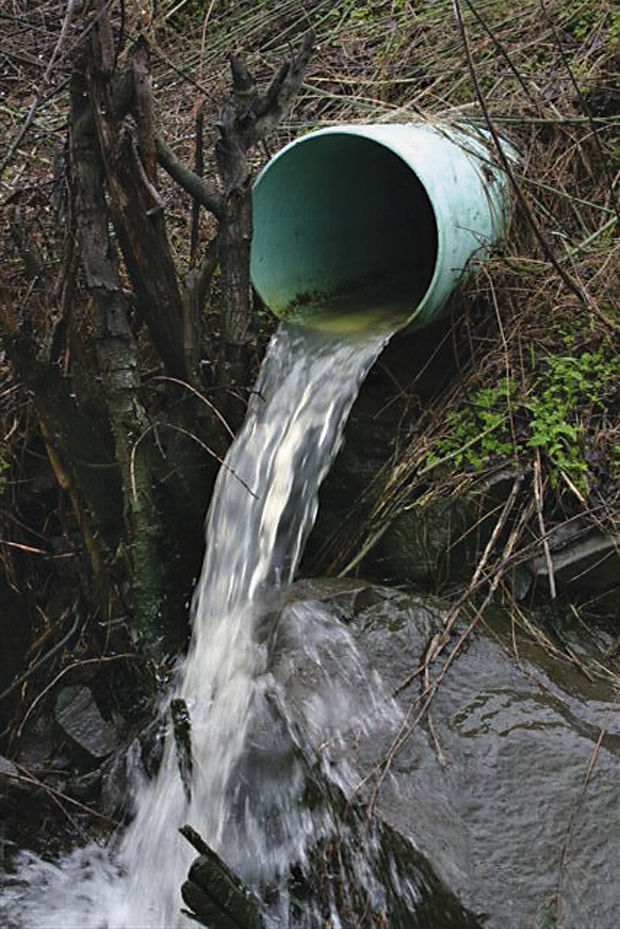
Stormwater outfall at Klindt Point in The Dalles, Oregon, February 2009. Herbicides and insecticide detection patterns for the solids filtered from stormwater runoff also follow a pattern of high contaminant concentrations in those samples with high suspended-sediment concentrations—particularly from Umatilla, Vancouver, and Willamette2. The pesticides analyzed on these solids are expected to be associated with and therefore, transported, with sediment and solids. Higher suspended-sediment concentration does not account for the complete pattern observed, however. The second largest suspended-sediment concentration measured in this study was at the Willamette3 site, but only 3 pesticides were detected in this sample compared with the 15 pesticides detected in the Willamette2-Dec sample. This indicates that land use in the drainage area likely is an important factor when examining occurrence and distribution. Examining land-use patterns was outside the scope of this report, but toxic-reduction efforts will be more effective when contaminant occurrence and distribution data is coupled with land-use information from the various stormwater catchments that drain to the Columbia River. The sample collected at the Willamette2 site in May included p,p′-DDT, which is somewhat unusual because it is not often the parent compound that is detected but rather one of the degradates, often p,p’-DDE. The pipe at the Willamette2 location drains an area that was historically used by a pesticide manufacturer. Therefore, remnants of contaminants from historical land uses may still be contributing to the receiving waters periodically through stormwater runoff. The stormwater samples from both Vancouver locations are notable for one compound, pendimethalin, a pre-emergent herbicide used for control of grassy weeds (Koski, 2008). Currently Used PesticidesNo single pesticide was detected at all of the locations where filtered-stormwater-runoff samples were analyzed, but among those detected, herbicides and insecticides were detected most often (table 19). This may have been caused by the timing of the samplings; however, no obvious pattern of detections was noted between the autumn/winter and spring storms. The highest numbers of detections were in the Portland/Willamette area, with the most detections and highest concentrations at the Willamette2 site. Detections for several pesticides and PCBs from the Willamette2 site in December and May exceeded chronic freshwater-quality criteria (table 20). Although many of these concentrations are low (less than 1 µg/L), mixtures of some of these pesticides have synergistic and additive effects on salmon health when they occur together (Scholz and others, 2006; Laetz and others, 2009). 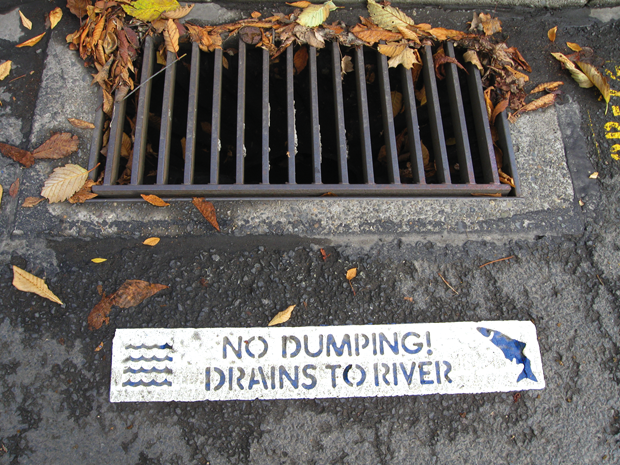
Stormwater drain, Portland, Oregon, October 2009. 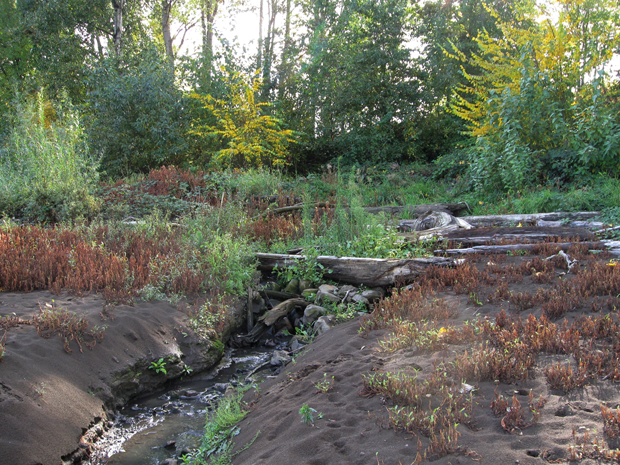
Stormwater outfall under west end of St. John’s railroad bridge (Willamette2), Portland, Oregon, October 2009. Polycyclic Aromatic HydrocarbonsMost concentrations of PAHs in stormwater runoff were low (less than the MDL), and the numbers of detections were consistent among locations, except for Hood River and St. Helens, where no PAHs were detected (table 21). Samples collected in the Portland/Vancouver area had the highest number of detections, likely due to the higher density of potential sources in the area, including industry and automobiles. In contrast, Umatilla is a small town with little urban development; however, the stormwater-runoff sample from Umatilla had a large number of detections. This is likely attributable to the large suspended-sediment concentration (834 mg/L, table 18) and the effects of roadway runoff adjacent to the site. Trace Elements and MercuryThe 10 trace elements measured in filtered and unfiltered stormwater runoff in this study were detected fairly consistently through all samples (table 22), except for mercury, silver, and selenium, which were detected in only about one‑half of the unfiltered-water samples. The detection limits are lower for filtered-water analyses; thus, selenium was detected at low concentrations in most of these samples, but mercury and silver were detected only in a few samples. The ratio of the concentration of each element in the filtered-water sample to that in the unfiltered-water sample indicates that selenium, cadmium, nickel, zinc, arsenic, and copper are transported more readily in the dissolved phase, whereas chromium, silver, lead, and mercury are more often transported in the solid phase (fig. 4). When suspended‑sediment concentrations are higher, such as in the samples from Umatilla, Willamette3, and Vancouver1 (table 18), higher concentrations are measured in both phases and the ratio shifts. Chronic and sometimes acute freshwater-quality criteria for cadmium, copper, lead, and zinc were exceeded at several stormwater-runoff sites (table 23). These concentrations also were high enough to potentially cause health effects in aquatic biota. Copper has been shown to cause sublethal effects on salmon at concentrations as low as 2 µg/L (Baldwin and others, 2003); most concentrations measured in this study were greater than 2 µg/L. Chromium and zinc have been determined to cause reproductive issues in rainbow trout at levels as low as 0.005 and 20 µg/L, respectively (Billard and Roubaud, 1985). All chromium and most zinc concentrations measured in this study (table 22) were higher than these sublethal effects levels. Although fish do not live in these stormwater pipes, the mixing zones where runoff enters their receiving waters are likely inhabited by biota. 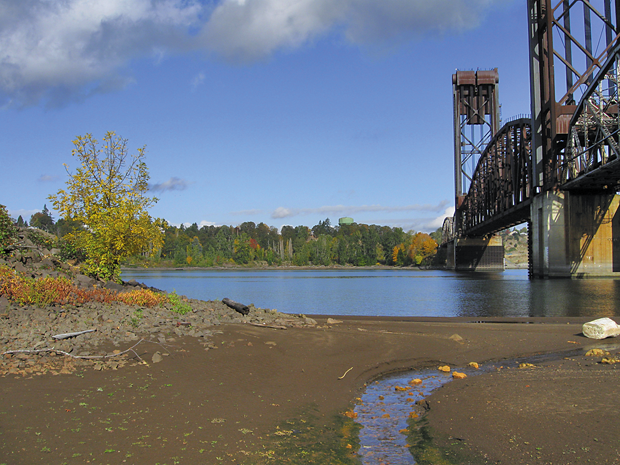
Stormwater runoff entering the Willamette River near the St. John’s railroad bridge, Portland, Oregon, October 2009. Although mercury was determined as part of the trace‑elements analytical suite at NWQL for all stormwater samples, aliquots from stormwater samples collected after November 2009 also were analyzed for mercury and methylmercury in unfiltered water at much lower detection limits at the Wisconsin Mercury Research Laboratory (table 15). The Willamette2 site continued to be a key contributor with the highest, by far, concentrations of all the stormwater samples at 230 ng/L in December and 74 ng/L in May. Although these values seem very high, they are less than the ODEQ-established screening level of 770 ng/L for total mercury in stormwater outfalls in the Portland Harbor area (Oregon Department of Environmental Quality and U.S. Environmental Protection Agency, 2005). The other locations with concentrations greater than or equal to the chronic criteria for freshwater aquatic life (12 ng/L) are Vancouver2, Willamette3, and Willamette4. The levels of methylmercury were all low, except at Willamette2, which was similar in concentration to that measured from The Dalles WWTP. 
Stormwater outfall near Interstate Highway 205 bridge (Portland1), Portland, Oregon, October 2009. Oil and GreaseOil and grease concentrations in this study were consistent and near or less than the reporting limit (table 24). The only location where concentrations were greater than the reporting limit was Willamette2. Analytical difficulties with these analyses caused method blanks often to show concentrations equal to one-half or more of the concentration in the environmental sample. SynopsisThe overall percentage of compounds detected in the stormwater-runoff samples (58 percent, or 114 of 195, fig. 5) was very similar to the percentage detected in WWTP-effluent samples (53 percent, or 112 of 120, fig. 3). The difference for stormwater is that the compounds detected were not similar across locations. Trace elements were detected at all sites and at levels of concern for the health of aquatic biota. All of the other compound classes were dominated by a few samples with high suspended-sediment concentrations—Umatilla, Willamette3, and Willamette2. The suspended-sediment contribution alone could not account for the large number and elevated concentrations measured at the Willamette2 site. Land-use sources in the drainage area play a key role at this site, which is located within an EPA Superfund project area. Two of the ubiquitous compound classes detected in the stormwater runoff, trace elements and PAHs, are related to automobiles and impervious surfaces, typical findings for stormwater runoff in urban areas. 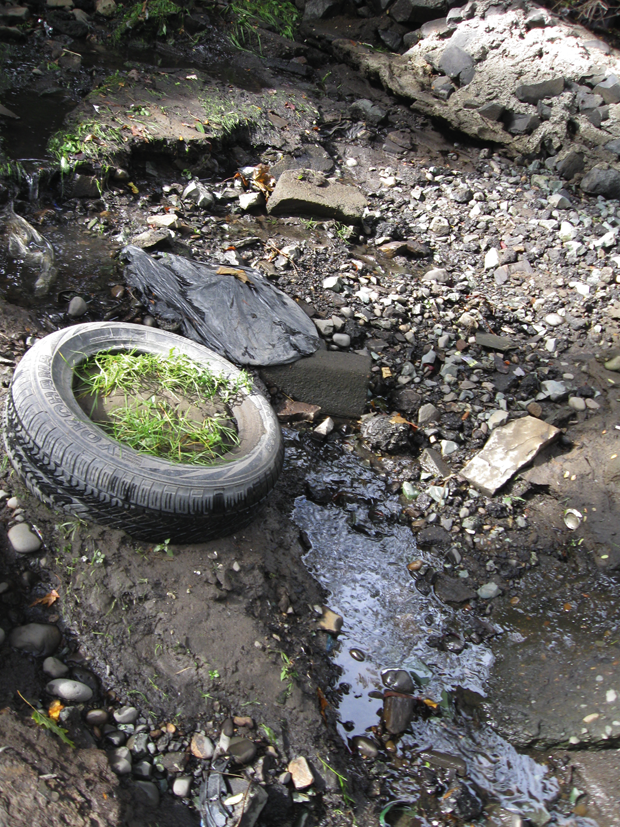
Urban stormwater outfall, Portland, Oregon, October 2009. 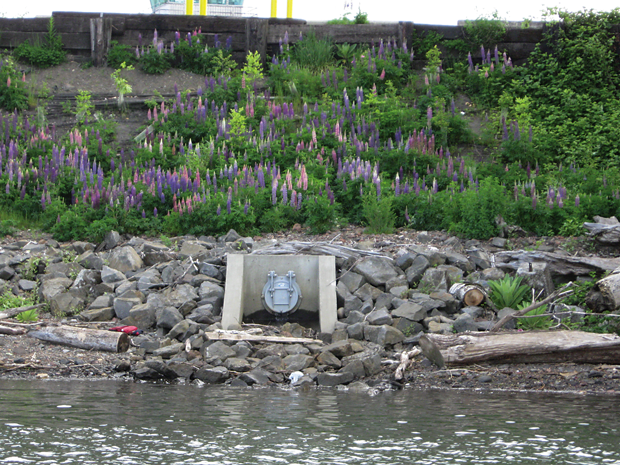
Stormwater outfall with spring flowers in downtown Portland, Oregon, May 2009. |
First posted April 25, 2012 For additional information contact: Part or all of this report is presented in Portable Document Format (PDF); the latest version of Adobe Reader or similar software is required to view it. Download the latest version of Adobe Reader, free of charge. |